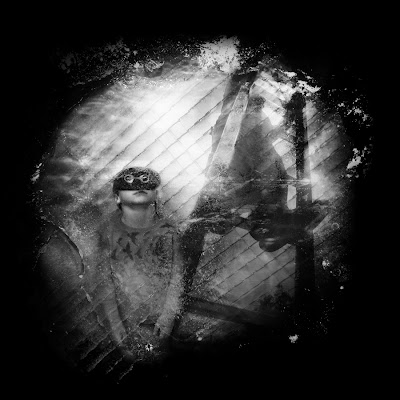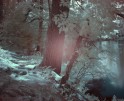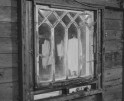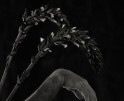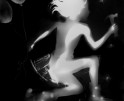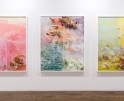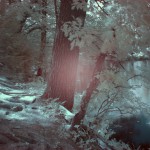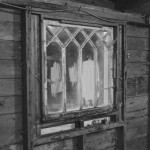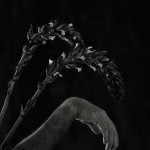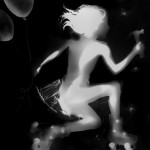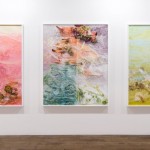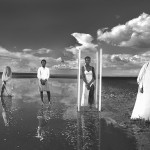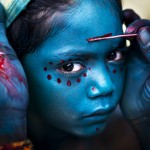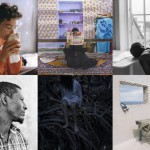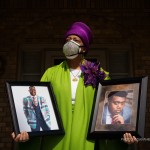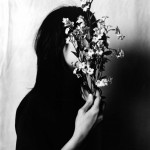Success Stories: Angela Bacon Kidwell
What seems like a lifetime ago, I spent a quiet afternoon down the rabbit hole of looking at photographs and came across the work of Angela Bacon Kidwell. I think I was on Flickr or some photo sharing site, and I discovered imagery that was powerful, unique, and compelling. I contacted Angela immediately and over the years, we have become friends and supporters. I have featured Angela’s work several times on Lenscratch, but when she recently shared her new work with me, I literally got the chills. Her work was breaking new ground and I knew it was time to highlight Angela’s many success stories.
Having a ringside seat at Angela’s trajectory, I have watched her professionalism, her artistry, and her thoughtful approach to the photographic journey take root and soar. Her photographs have fans around the world; she has garnered award after award, most recently, winning First Place in the Texas Photographic Society International Competition, is one of the ten finalists for the John Clarence Laughlin Award, and has been nominated for the Santa Fe Prize for Photography. Her work is exhibited all across America and featured in numerous magazines. Born in Dallas, and now living in Wichita Falls, Texas, Angela draws inspiration from her life and experiences, her family, and surroundings. She’s a thinker, a dreamer, and a true artist.
Her new series, Traces of Existence, combines emotion, travel, the unknown, and the new, all mixing into new ways of working and seeing.
The motive in this body of work is to mend the tension and tragedy created when conflicting emotions meet. Walking through the highs of my recent travel to China and the lows of significant personal loss, I have been searching for a visual level of communication that would unite traces of my existence. I have become increasingly fascinated by how tenacious life is and yet how in a moment survival ceases. The fragility of life is represented in this work by a personal language of symbols. I want all my images to have real meaning for me, even if it is not easily read by the viewer. By working more abstractly, the dissimilar images connect to one another in unexpected ways causing a thought or idea to evolve. The juxtaposition of death and despair, represented by skeletons, old age and holes connected to a joyous life filled with children, birds and Ferris Wheels examine the complicated and chaotic ways in which life contracts, expands, converges and divests in our personal journeys. By stretching the image to near disintegration by burning, freezing and submersions I seek to release my emotions and give respect to a life that has been fully lived. The emotions I sought to bandage together resulted in a somber, but completely liberating experience.
Process: Numerous layers of hand painted photographs, drawings and resin make up a single image. The final results are a complex layering process and not complete digital manipulations. The image is printed and re-photographed under various conditions in one final effort to heal the tender wounds that bind my own existence.
You state that the work was created as a way to “mend the tension and tragedy created when conflicting emotions meet. Walking through the highs of my recent travel to China and the lows of significant personal loss, I have been searching for a visual level of communication that would unite traces of my existence.” Has the process of creating the work been therapeutic for you?
The short answer is yes, but let me give you a little background on how the work evolved and share a simple quote I stumbled across while in China that helped lead me in producing this body of work.
“You cannot prevent the birds of sorrow from flying over your head, but you can prevent them from building nests in your hair”. — Old Chinese Proverb
Over the last several years, I’ve been working on a series that address the complex stages of grief after a death. During this time, of searching and gathering my ideas I was simultaneously processing two events in my life: First, the joy of my travels in China and second the loneliness that followed significant personal losses. I decided to take a detour from the new series and move in closer to some of specific events and emotions in my immediate space. The decision I made was to limit myself loosely to the photographs I took in China, personal effects from my grandparents’ home and images my son and I took the last day we occupied their home. My vision was to create a new object that would tie and seal my recent experiences into a single ambiguous memory. And, to keep those nests out!
The process of creating the work became therapeutic because it forced me to work abstractly with the subjects and that helped to create order, distance and a bridge between my internal and external worlds. The work took a considerable amount of time and energy to create, and the more layers an image embodied the more “new” life it took on. The long process of creating each image allowed much time to pass, and you know the saying “time heals all wounds”. It helps.
Did your trip to China change how you see and how make work?
My trip reinforced by belief that images have power beyond what we are able to communicate verbally. There was clearly a barrier in my communications with the people in China but our understanding of visual language provided an alternative to the lack of verbal ability. We are all much more similar than different. This reaffirmation helped me to explore a new way of creating and I sensed that the work would be able to communicate universally. At least I hoped it would.
Your approach is totally unique—hand painting, resin, photographing…can you describe this process?
Once I decided to shape the photographs and objects into a new story or expression the path became quite clear. I wanted to experience an emotional release with each layer of the image. I felt like many times creating the work I was going through certain stages of grief. There are many stages of grief, and they don’t follow a systematic order. They are messy, and this work was messy to create. I printed hundreds of images and began to deconstruct them by cutting, tearing, layering other objects, drawing and painting. The assemblage of the work allowed me to experience different emotions: the tearing and cutting was aggressive contrasted with the painting and drawing that was contemplative. There was a dance that I went through with each individual image- pushing it to near disintegration and then rescuing it again till I was finally ready to let it be. The final stage consisted of defrosting images, and at times allowing my son to interact with the melting image, submerging an image in water for days while adding oil to the water and watching it move, and burning the image. I re-photographed the images going through a new metamorphosis before the image would cease to exist. The final step was a visual and emotional closure.
Was there a reason for working in Black and White?
Honestly, I never considered approaching this work in color. I saw it in black and white.
How does living in a small town in Texas, without the influences of a metropolitan experience and an active physical photo community, affect making work?
I was raised in Dallas, Texas and even though that is a large city I always felt I would move to a larger city such as LA or NY to pursue the arts. Instead, thirteen years ago I moved to Wichita Falls, Texas and this city has boosted my artistic spirit. I do believe that I could be creative anywhere, but I feel where I live is truly conducive to the way I work. I’m a receiver type of personality, and I absorb the energy that is going on in my immediate environment so high energy cities tend to drain me over a period of time. I’m much more productive and peaceful in a small town. The city I live in has a rich, and talented artistic community, and many of my early mentors live here, and that brings about a feeling of safety for me which helps keep me centered.
Your son Bleu has been integral part of your image making. How does he feel about being part of you photographic journey?
Since the moment, he was born I knew I would no longer create in solitude but with a partner. The last six years with Bleu have been nothing short of amazing for me, and I’ll take it so far as to say he has had a pretty interesting, creative childhood.
But, I’ll let him answer that question for himself.
How do you feel about taking pictures, Bleu? from Angela Bacon-Kidwell on Vimeo.
How do you juggle your ever growing success and the demands of motherhood?
Without a doubt, my husband and son are my biggest supporters-on a good day. No, honestly my husband although not a creative being and I know I drive him crazy at times is always in my corner. He understands me and my need to create and explore. He calls me the “white tornado” because I have a ton of energy and I’m rarely still. I can get a lot done! My focus the last eleven years has been on my work and family and one would not succeed without the other. They work in tandem so to speak. I feel very blessed and thankful and would not change a single thing about my life.
What advice can you give emerging photographers, especially on presentation, on networking, on consistently producing excellent work?
The best advice I can share is to attempt to be in a constant state of graciousness. We all have so much to be thankful for, and if you can believe that where you are at the present moment is exactly where you are supposed to be then you are free to create and enjoy what is around you in the present. I started out sharing work via different photography, and social networking sites and my involvement with this media allowed me to gain exposure. The feedback I received from all around the world was crucial because it gave me a boost in confidence to present my work to reviews and competitions. I know networking via Facebook etc… is relevant, but it is also crucial to devote the majority of your time to your own creativity and sometimes too much networking steals precious time. I feel I’m getting closer to my truer self in recent years, and that comes from having a quieter mind and, tweeting etc… is not harmonious with peace. I also think that if you are being honest with yourself then the people that can help you show up in your life at just the right moment without enormous effort on your part. You did that for me years ago, Aline. Thank you!
To be consistent at anything in life you have to keep trying different avenues of expression- it’s all in the doing and doing a ton that produces better work and better work attracts a larger audience. It is a numbers game.
What opportunity took your career to the next level?
Without a doubt, Photolucdia and Review Santa Fe in 2008 opened up some wonderful doors for me and allowed me meet some amazing fellow artists. I think it is also very important to surround yourself with a few caring individuals that support you and your vision. Even one is fine.
Do you ever have periods of self-doubt and feel creatively unmotivated?
Yes, but I don’t focus on those feelings. Every fiber of my being is about creating so I paint something, make something, do something. I’m never without a creative project going on in my life even if it has nothing to do with photography the act of making always impacts the next artistic endeavor. Most people think that being a creative person and living a creative life comes easily but it is a ton of actual work. Of course, there are moments of unique vision but those are fleeting- it is work and for unknown reasons it must come out of me. Annoying sometimes but I wholeheartedly accept it.
And finally, what would be your perfect day?
Finishing this interview is a nice day. Now back to doing. If, the doing goes good today than it is a perfect day!
Posts on Lenscratch may not be reproduced without the permission of the Lenscratch staff and the photographer.
Recommended
-
Interview with Kate Greene: Photographing What Is UnseenFebruary 20th, 2024
-
Semana Mexicana: Felipe “Chito” TenorioFebruary 5th, 2024
-
Amy Lovera in Conversation with Douglas BreaultJanuary 23rd, 2024
-
Michelle Bui: Affinités poreusesDecember 27th, 2023



